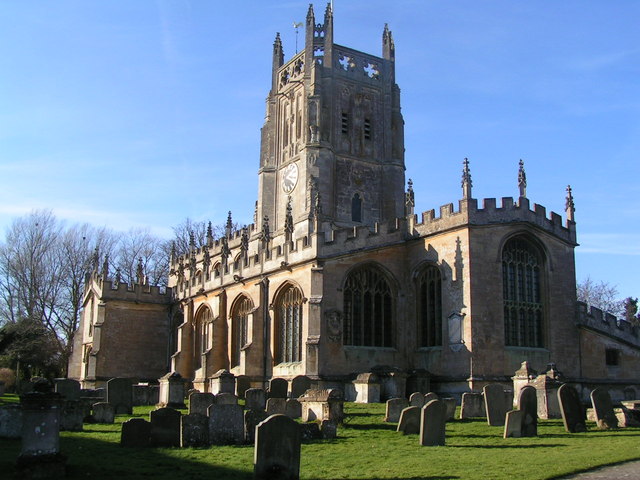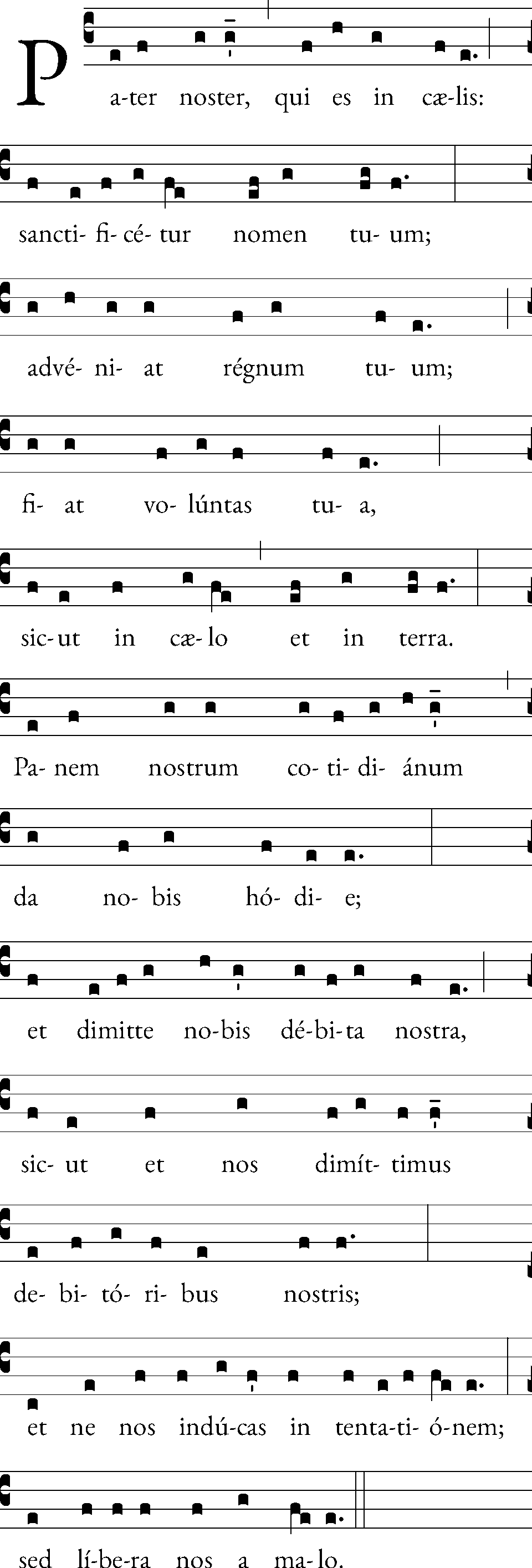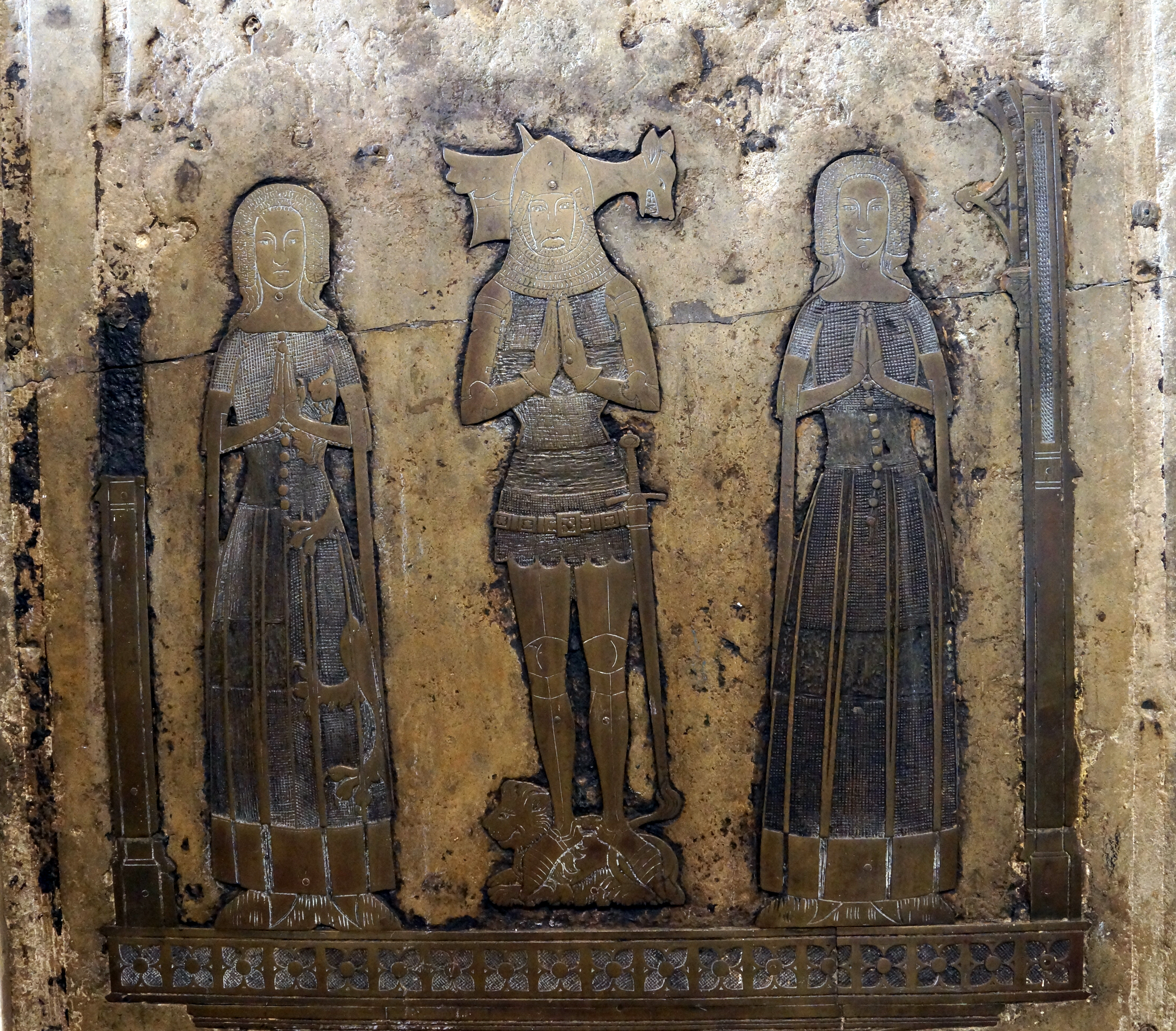|
St Mary's Church, Fairford
St Mary's Church is a Church of England church in Fairford, Gloucestershire, England. It is notable for its complete set of 28 medieval stained-glass windows, one of the best-preserved in England. Part of the tower dates from the early 15th century. The church was rebuilt at the end of the 15th century by John Tame (c.1430–1500), a wealthy local wool merchant. It is a Grade I listed building in the Perpendicular style. Interior Tame rebuilt the church purposely to install his stained glass, and thus the design is "necessarily somewhat cramped". The church was consecrated in 1497 by the Bishop of Worcester, within whose diocese lay most of Gloucestershire at that time. It consists of a chancel, nave, a tower between them, and two aisles, which extend without any external break to about half the length of the chancel. According to Neale "This arrangement, necessary to secure the required number of windows, somewhat injures the effect of the exterior, and makes the distinction ... [...More Info...] [...Related Items...] OR: [Wikipedia] [Google] [Baidu] |
Fairford
Fairford is a town in Gloucestershire, England. The town lies in the Cotswold hills on the River Coln, east of Cirencester, west of Lechlade and north of Swindon. Nearby are RAF Fairford and the Cotswold Water Park. History Evidence of settlement in Fairford dates back to the 9th century and it received a royal market grant in the 12th century. In the Domesday book, Fairford was listed as ''Fareforde''. In 1066 there were three mills one of which was used in the wool trade in the 13th century. The mill that survives today was built in the 17th century. Governance Fairford has a Parish Council with 13 members. The mayor is James Nicholls. After a boundary review implemented for the 2015 local elections, Fairford was split into two District Council electoral wards called Fairford North Ward (single member) and Lechlade, Kempsford and Fairford South Ward (two member). On Cotswold District Council Fairford North Ward is represented by Liberal Democrat Andrew Doherty and Lechl ... [...More Info...] [...Related Items...] OR: [Wikipedia] [Google] [Baidu] |
Barnard Flower
Barnard Flower (died July or August 1517) was a Flemish glazier. He was King's Glazier to Henry VII and Henry VIII from 1505 to 1517, the first non-Englishman to hold this office. Flower came to work in England in the late 15th century. By 1496 he was working for Henry VIII providing glass for Woodstock and then Sheen Palace the following year. He was based in Southwark to avoid the restrictions imposed by the Glaziers' Company in the City of London. Stained glass attributed to Flower include parts of the West Window of St George's Chapel, Windsor, windows in King's College Chapel, Cambridge, and most of the glazing at St Mary's Church, Fairford, which has the most complete set of mediaeval stained glass windows in England. Flower's successor as the King's Glazier was Galyon Hone who had trained in Antwerp.Carola Hicks Carola Hicks (7 November 1941 – 23 June 2010) was a British art historian. She was born Carola Brown in Bognor Regis, West Sussex, and educated at the ... [...More Info...] [...Related Items...] OR: [Wikipedia] [Google] [Baidu] |
Monumental Brasses Of Gloucestershire
About 80 ancient monumental brasses survive in Gloucestershire, many in the parish churches at Cirencester and Northleach. Many have been lost to theft over the ages. The first complete listing of brasses in Gloucestershire was made by Cecil T Davis who stated that they may be divided into three categories: ecclesiastical, military and civil.Davis (1881–2), pp. 339–344. List of monumental brasses of Gloucestershire References Sources *Davis, Cecil T. (1881-2List of Monumental Brasses in Gloucestershire Bristol and Gloucestershire Archaeological Society, Vol. 6, Transactions at Gloucester. *Davis, Cecil T. (1899The Monumental Brasses of Gloucestershire *{{cite book , first1=William , last1=Lack , first2=H. Martin , last2=Stuchfield , first3=Philip , last3=Whittemore , title=The Monumental Brasses of Gloucestershire , series=Monumental Brass Society County Series , location=London , publisher=Monumental Brass Society , year=2005 , isbn=9780954327125 Monumental bras ... [...More Info...] [...Related Items...] OR: [Wikipedia] [Google] [Baidu] |
John Mason Neale
John Mason Neale (24 January 1818 – 6 August 1866) was an English Anglican priest, scholar and hymnwriter. He worked and wrote on a wide range of holy Christian texts, including obscure medieval hymns, both Western and Eastern. Among his most famous hymns is the 1853 ''Good King Wenceslas'', set on Boxing Day. An Anglo-Catholic, Neale's works have found positive reception in high-church Anglicanism and Western Rite Orthodoxy. Life Neale was born in London on 24 January 1818, his parents being the clergyman Cornelius Neale and Susanna Neale, daughter of John Mason Good. A younger sister Elizabeth Neale (1822–1901) founded the Community of the Holy Cross. He was educated at Sherborne School, Dorset, and Trinity College, Cambridge, where (despite being said to be the best classical scholar in his year) his lack of ability in mathematics prevented him taking an honours degree. Neale was named after the Puritan cleric and hymn writer John Mason (1645–94), of whom his mothe ... [...More Info...] [...Related Items...] OR: [Wikipedia] [Google] [Baidu] |
Hail Mary
The Hail Mary ( la, Ave Maria) is a traditional Christian prayer addressing Mary, the mother of Jesus. The prayer is based on two biblical passages featured in the Gospel of Luke: the Angel Gabriel's visit to Mary (the Annunciation) and Mary's subsequent visit to Elisabeth, the mother of John the Baptist (the Visitation). The Hail Mary is a prayer of praise for and of petition to Mary, regarded as the Theotokos (Mother of God). Since the 16th century, the version of the prayer used in the Catholic Church closes with an appeal for her intercession. The prayer takes different forms in various traditions and has often been set to music. In the Latin Church, the Hail Mary forms the basis of other prayers such as the Angelus and the Rosary. In the psalmody of the Oriental Orthodox Churches a daily Theotokion is devoted to ascribing praise to the Mother of God. The Eastern Orthodox Churches have apart from the ''Theotokion'' a quite similar prayer to the Hail Mary (without expli ... [...More Info...] [...Related Items...] OR: [Wikipedia] [Google] [Baidu] |
Pater Noster
The Lord's Prayer, also called the Our Father or Pater Noster, is a central Christian prayer which Jesus taught as the way to pray. Two versions of this prayer are recorded in the gospels: a longer form within the Sermon on the Mount in the Gospel of Matthew, and a shorter form in the Gospel of Luke when "one of his disciples said to him, 'Lord, teach us to pray, as John taught his disciples. Regarding the presence of the two versions, some have suggested that both were original, the Matthean version spoken by Jesus early in his ministry in Galilee, and the Lucan version one year later, "very likely in Judea". The first three of the seven petitions in Matthew address God; the other four are related to human needs and concerns. Matthew's account alone includes the "Your will be done" and the "Rescue us from the evil one" (or "Deliver us from evil") petitions. Both original Greek texts contain the adjective ''epiousios'', which does not appear in any other classical or Koine Greek ... [...More Info...] [...Related Items...] OR: [Wikipedia] [Google] [Baidu] |
Monumental Brass
A monumental brass is a type of engraved sepulchral memorial, which in the 13th century began to partially take the place of three-dimensional monuments and effigies carved in stone or wood. Made of hard latten or sheet brass, let into the pavement, and thus forming no obstruction in the space required for the services of the church, they speedily came into general use, and continued to be a favourite style of sepulchral memorial for three centuries. In Europe Besides their great value as historical monuments, monumental brasses are interesting as authentic contemporary evidence of the varieties of armour and costume, or the peculiarities of palaeography and heraldic designs, and they are often the only authoritative records of the intricate details of family history. Although the intrinsic value of the metal has unfortunately contributed to the wholesale spoliation of these interesting monuments, they are still found in remarkable profusion in England, and they were at one time ... [...More Info...] [...Related Items...] OR: [Wikipedia] [Google] [Baidu] |
Purbeck Marble
Purbeck Marble is a fossiliferous limestone found in the Isle of Purbeck, a peninsula in south-east Dorset, England. It is a variety of Purbeck stone that has been quarried since at least Roman times as a decorative building stone. Geology Stratigraphically these limestone beds lie towards the top of the Durlston Formation of the Purbeck Group. They were deposited during the Berriasian age of the Early Cretaceous epoch. Purbeck Marble is not a metamorphic rock, like a true marble, but is so-called because it can take a fine polish. Its characteristic appearance comes from densely packed shells of the freshwater snail ''Viviparus''. Sussex Marble is similar in type. The 'marble' is properly classified as a biomicrudite, as it consists of large clasts (the snail shells) in a fine-grained limestone mud matrix. The individual marble beds (also known as 'seams'), lie between layers of softer marine clays and mudstone, laid down during repeated marine ingressions. Some of the beds ... [...More Info...] [...Related Items...] OR: [Wikipedia] [Google] [Baidu] |
Tomb
A tomb ( grc-gre, τύμβος ''tumbos'') is a :wikt:repository, repository for the remains of the dead. It is generally any structurally enclosed interment space or burial chamber, of varying sizes. Placing a corpse into a tomb can be called ''immurement'', and is a method of Disposal of human corpses, final disposition, as an alternative to cremation or burial. Overview The word is used in a broad sense to encompass a number of such types of places of interment or, occasionally, grave (burial), burial, including: * Shrine, Architectural shrines – in Christianity, an architectural shrine above a saint's first grave (burial), place of burial, as opposed to a similar shrine on which stands a reliquary or feretory into which the saint's remains have been transferred * Burial vault (tomb), Burial vault – a stone or brick-lined underground space for multiple burials, originally vault (architecture), vaulted, often privately owned for specific family groups; usually benea ... [...More Info...] [...Related Items...] OR: [Wikipedia] [Google] [Baidu] |





